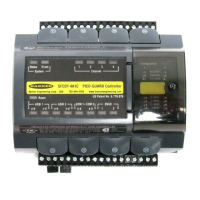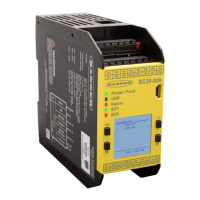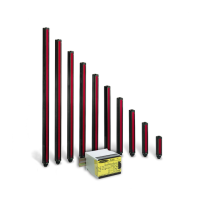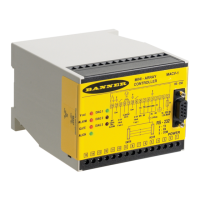30 P/N 69761 rev. B
Banner Engineering Corp. • Minneapolis, U.S.A.
www.bannerengineering.com • Tel: 763.544.3164
PICO-GUARD Controller
Instruction Manual
The Banner BT-1 Beam Tracker is a very good tool for
detecting electrical noise. It can be used to detect electrical
transient spikes and surges. Cover the lens of the BT-1 with
electrical tape to block light from getting into the receiver lens.
Press the “RCV” button on the BT-1 and position the Beam
Tracker on the wires going to the PICO-GUARD or any other
nearby wires. The LED of the BT-1 will flash when noise is
detected. Noise caused by the switching of inductive loads
should be addressed by installing proper transient suppression
across the load.
Checking for sources of optical noise: Turn off the controller,
completely block the emitter beam, or disconnect the emitter
channel fiber at the controller, then use a Banner BT-1 Beam
Tracker to check for light at the receiving optical element.
Press the “RCV” button on the BT-1 and move it near the front
of the receiving optical element’s sensing window. If the
BT-1’s indicator lights, check for light from other sources
(other safety light screens, grids or points, or standard
photoelectric sensors) by “tracking down” the emitted light
from them.
Troubleshooting and Maintenance
Error
Code*
Indicators
Flashing Red
Error Description Appropriate Action
0
• System Status
• USSI 1 Reset
USSI 1 Reset Error
• USSI 1 Reset switch closed on power-up or
during system reset after lockout
• USSI 1 Reset external wiring fault
• Excessive EMI/RFI noise
• Check switch position and wiring for proper input
signal. Replace switch and/or repair wiring.
• Intermittent error: check for loose connections and/
or EMI/RFI noise.
1
• System Status
• OSSD 1
or
• System Status
• OSSD 2
OSSD Error
• OSSD 1 or 2 overload
• OSSD 1 or 2 external wiring fault
• Check load rating. Must be < 0.5A dc.
• Disconnect loads. If OK, then check wiring. If error
continues, replace controller.
2
• System Status
• System Reset
System Reset Error
• System Reset switch closed on power-up or
during recovery from a USSI lockout
• System Reset external wiring fault
• Excessive EMI/RFI noise
• Check switch position and wiring for proper input
signal. Replace switch and/or repair wiring.
• Intermittent error: check for loose connections and/
or EMI/RFI noise.
• System Status
• System Reset
• USSI 1 Reset
• System Reset shorted to USSI 1 Reset • Check wiring for short.
3
• System Status
Controller Error
• Excessive EMI/RFI noise
• Internal failure
• Intermittent error: check for loose connections and/
or EMI/RFI noise.
• Replace controller.
4
• System Status
• USSI 1 a-b
• USSI 1 c-d
or
• System Status
• USSI 1 a-b
or
• System Status
• USSI 1 c-d
USSI 2 Error
• Device OSSD type mismatch
• Simultaneity error (> 3 seconds)
• USSI external wiring fault
• Excessive EMI/RFI noise
• Verify device OSSD types (see Section 3.7).
• Check operation of device outputs.
• Check wiring for shorts or opens.
• Intermittent error: check for loose connections and/
or EMI/RFI noise.
(See Section 5.1 for recovery procedure.)
5
• System Status
• USSI 2 a-b
• USSI 2 c-d
or
• System Status
• USSI 2 a-b
or
• System Status
• USSI 2 c-d
External stop device 2 Error
• Device OSSD type mismatch
• Simultaneity error (> 3 seconds)
• external stop device external wiring fault
• Excessive EMI/RFI noise
• Verify device OSSD types (see Section 3.7).
• Check operation of device outputs.
• Check wiring for shorts or opens.
• Intermittent error: check for loose connections and/
or EMI/RFI noise.
(See Section 5.1 for recovery procedure.)
*Error Code is not visible on controller. Obtain error codes via RS-232 interface to PC or other device.
Figure 5-1. Error code troubleshooting (1 of 2)

